Axum
Axum is one of the most historical significant and fascinating towns, found along the main northern circuit of Ethiopia. It was the original capital city, and the epicentre of the Axumite Empire, a once formidable global power. The relics that remain from that era rest in Axum, and visiting the city is to journey through time, and gain an insight into a long-lost civilisation.
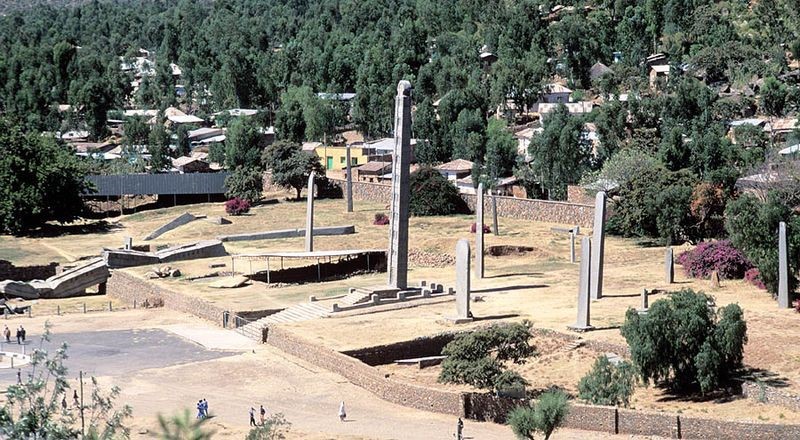
The major attraction of the town is the obelisks, ancient grave markings of the Axumite Empire; they have fascinating history dating back to 400 BCE. These incredible structures became a UNESCO World Heritage Site back in 1980. The structures rise dozens of metres into the sky, and the history of their construction (and subsequent theft by the Italians and repatriation) are fascinating. Another popular site in Axum – and one that adds to the general mystique of the town -is the Church of Saint Mary of Zion. It is one of the most sacred of places of Christian’s in the whole of Ethiopia, not only does it house the Ark of the Covenant, but also has a long history dating back some 1,700 years. In the same area, researchers have uncovered a number of tombs in Axum since the 1970s, but sadly many had been plundered by tomb raiders and only one such grave, The Tomb of the False Door, is now open to visitors. This World Heritage site is often referred to as “Abyssinia” in medieval texts and is considered the heart of ancient Ethiopia. It is a marvel of obelisks, ruins of castles, undiscovered tombs, beautiful churches and other cultural treasures spanning several centuries and embracing different religions. It is also strategic place to visit other cultural and historical places of Tigray regional state of Ethiopia.
Lalibela
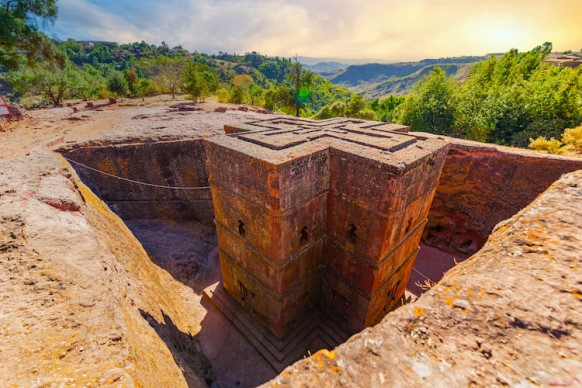
The small town of Lalibela Perched in Ethiopia’s Lasta Mountains at 2,600m (8,530ft), is home to one of the world’s most astounding sacred sites: Lalibela Rock-hewn Churches, a, UNESCO World Heritage Site is home to eleven medieval rock-hewn churches, carved. These churches are carved entirely out of a single solid rock with its roof at ground level in the 12th century. It is a testament to Ethiopia’s rich architectural and religious history.
Religious ritual is central to the life of the town, with regular processions, extensive fasts, crowds of singing and dancing priests. This, combined with its extraordinary religious architecture and simplicity of life, gives the city of Lalibela a distinctively timeless, almost biblical atmosphere.
When King Lalibela decided to re-create Jerusalem in Ethiopia in the 12th century, he carved it from the volcanic rock beneath his feet. And he didn’t stop with one church, today 13 stands waiting to be explored. Occupying a roughly triangular 15 hectare site either side of a rock-cut stream known locally as the Jordan River, the rock-hewn churches in Lalibela are found in two main clusters with the magnificent Bet Giyorgis standing in glorious isolation about 300 metres from the other churches.
The northern cluster of seven churches and chapels seem to have a much greater cohesion and sense of order. Some argue this supports the idea that it was constructed from a cogent plan, perhaps made by a powerful ruler like King Lalibela.
The southern cluster, found 250 metres from the northern cluster, is made up of seven churches. Here order is less visible. Symmetry is rare. Steps and hand holds have been worn wide and smooth by constant use. It feels older; the explanations for the churches and tunnels are less certain, which create room for imagination.
Architecturally, the churches of the northern cluster are subterranean monoliths or three-quarter monoliths. The walls have been dug from the surrounding rock on three of four sides before the interiors are then ground away to amazing effect. The remaining churches have been cut into existing rock faces, fissures and caves; a simpler form of construction that also indicates greater antiquity. Its uniqueness is attracting thousand international visitors across the globe.
Harar

Dating back to the previous millennium, the beautiful city of Harar is one of the oldest cities in Ethiopia. Located on the border of the far eastern Somali region, this UNESCO World Heritage Site has a spiritual aura that will take you back to medieval times, having a very different feel to the rest of Ethiopia.
Regarded to as the fourth holiest city in Islam, the old city of Harar is home to an incredible 99 mosques and shrines, representing the 99 names of Allah known to man. It is believed that Sheikh Abadir Umar ar-Rida, the Arab Muslim cleric patron of the city of Harar, is responsible for the Islamic demographic of this ancient city.
Known for its famous array of markets, the famous Hyena Men, ancient paintings and artefacts spanning all cultures, it’s easy to get lost in the never-ending maze of the winding streets of Harar.
The Jugol wall
Believed to be built somewhere between the 13th and 16th century, this thick, 5 metre high and 3.5km long wall was built as a fortress surrounding the ancient city.

This fascinating wall once had five gates: Shoa Gate, Buda Gate, Sanga Gate, Erer Gate and Fallana Gate, each providing five pathways into five different quarters of the city. Still intact, the Jugol wall has become an icon of the city.
Hyenas Man

Harar is most famous for its Hyena Man. Feeding hyenas is actually a thing in this part of town. It all started in the 20th century when the Harari people started feeding the local hyenas to stop them from decimating their livestock. Consequently, these large, grizzled hyenas stopped searching for their own food and started coming into the city to get their red meat from the local hyena man. A whole century has since passed, but this tradition continues as the hyenas still come out at night to be fed by the local people.
The Sherif Museum
One of the most decorated museums in the city of Harar. Believed to have hosted the honeymoon of Haile Selassie and his wife Menen Asfaw, the Sherif Harar city museum is filled with jewellery, coins, weaponry, textiles and old manuscripts collected from across the region, including Amhara, Gurage, Oromo, Somali and Argoba

The Arthur Rimbaud Museum
Right in the heart of this mystic city is the Arthur Rimbaud Museum. Dedicated to the famous French poet Arthur Rimbaud, known for his influence on modern literature, this articulate museum is filled with beautiful photos, all telling a different story.
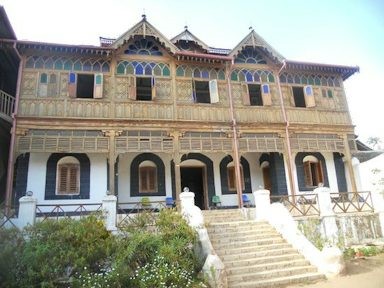
Tiya
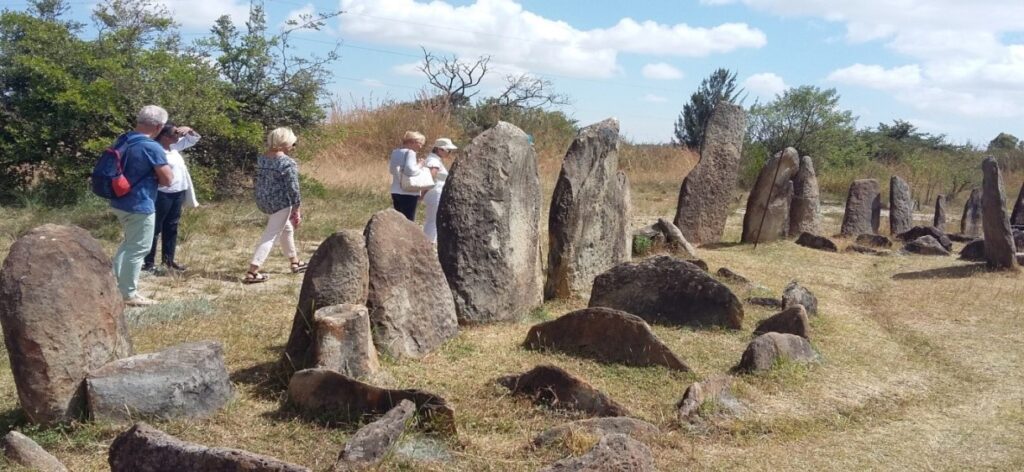
It is a UNESCO recognized world heritage site, located in the Ethiopian highlands, about 70 km south of Addis Ababa. It is a place shrouded in mystery, where 36 stone steles – considered to be representative of similar stele found elsewhere in the region – stand to attention in an area where tombs are also found. They are assumed to have some kind of funerary significance, but their age and origin is unknown. Most of the stele stands 1-5 m high, is carved with symbols, including depictions of swords and schematic human figures.
Gonder
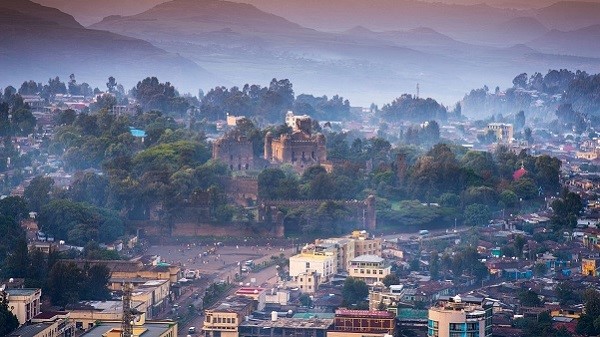
Dubbed the Camelot of Africa, the city of Gondar — capital of Ethiopia from 1636 until the mid-19th century — combines a modern veneer with an architectural sensibility harking back to the middle Ages. King Fasil oversaw the construction of the medieval castles, forty four churches, bridges and other infrastructure in the city. The city’s physical and architectural centrepiece is Fasil Ghebbi (UNESCO World Heritage Site), a stone-walled royal compound containing half a dozen fairy-tale castles including the three-storey, original built by Emperor Fasil in the 1630s. The most striking is Emperor Fasil’s three-storey castle, which stands 32 meters high, and displays a blend of Portuguese and Indian and indigenous Aksumite influences. Also incorporates several more remote constructions, most notably the Church of Debre Berhan Selassie, with its beautifully painted interior.
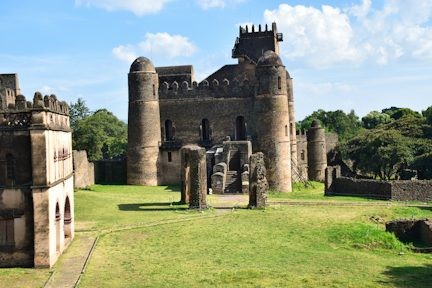
Azmaries (Traditional singers) welcome guests with entertaining poems and songs and invites them to revisit the city. The presence of extra number of cultural musicians adds a moon light and greater value to record unforgettable memory to one’s journey. Everywhere you go in the city, you could have the opportunity to entertain at the cultural night clubs. The poems and tune of each Azmary (cultural musicians) with their cultural alcoholic drinks; like Tej, Tella and Areki, presented to you, keeping the traditional way of presentation and modern drinks as well, will make you more happier and feel dynamic in your trip.
Timket (Epiphany) Festival in Gondar
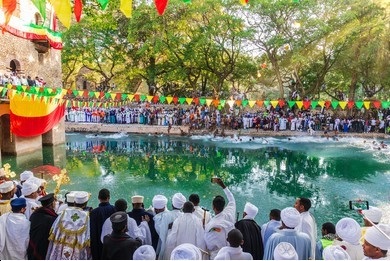
In Gondar, the bathing palace of Fasiledas is still dedicated to this colourful ceremony. It is still filled with water each year by a canal from the River Keha for the colorful Timket celebration. Besides the baptism of Jesus Christ, the celebration of Timket in Gondar also commemorates the re-baptizing of thousands of people who have converted from Catholicism to the Orthodox faith. Even though Gondar can be visited at any time of the year, the city is a wonderful place of visit during this season as it gives one a chance to witness the colorful ceremonies of the timket Festival.
Disclaimer: The official text of the Embassy Website is the English language version. Any discrepancies or differences created in translations are not binding and have no legal effect for compliance or enforcement purposes.